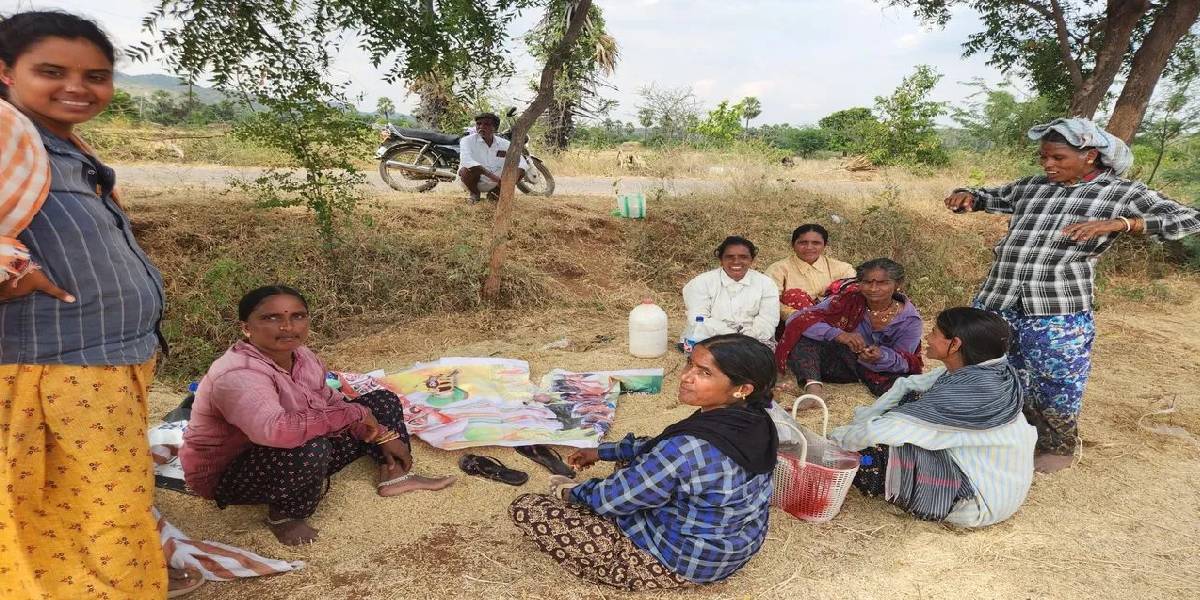Besides the distribution of one crore “Indiramma sarees” to poor women, Revanth is also opening the digital doors for the state’s women Self‑Help Groups by onboarding them onto Amazon’s e‑commerce platform for national and global markets.
Published Nov 21, 2025 | 8:00 AM ⚊ Updated Nov 21, 2025 | 8:00 AM

Telangana has a little over 1.67 crore rural voters, with women tipping the scales (around 85.28 lakh women versus 82.04 lakh men), pushing women’s share to roughly 51 percent.
Synopsis: The Congress government has left no one guessing about linking the saree rollout with its political calendar. As per the official plan, one crore sarees will be distributed in two phases: about 65 lakh sarees in rural areas between 19 November and 9 December, and the remaining 35 lakh sarees in urban areas from 1 March to 8 March 2026, to coincide with International Women’s Day.
In a carefully orchestrated women-first initiative ahead of the local body polls, Telangana Chief Minister A Revanth Reddy has rolled out the red carpet for two marquee initiatives targeted at the rural women voters.
Besides the distribution of one crore “Indiramma sarees” to poor women, Revanth is also opening the digital doors for the state’s women Self‑Help Groups (SHGs) by onboarding them onto Amazon’s e‑commerce platform for national and global markets.
Both moves were launched or announced on the occasion of the birth anniversary of former Prime Minister Indira Gandhi and are being portrayed as the Congress’s brand of women’s empowerment.
Political rivals, however, see them as a pre‑poll blitz taking dead aim at the single-most decisive bloc in the upcoming Gram Panchayat elections: rural women voters and the extensive SHG network that doubles up as a veritable door‑to‑door political campaign machine.
Telangana has a little over 1.67 crore rural voters, with women tipping the scales (around 85.28 lakh women versus 82.04 lakh men), pushing women’s share to roughly 51 percent.
The state has about 12,800–12,867 gram panchayats and over 1.13 lakh wards, where the Telangana Panchayat Raj Act’s minimum 50 percent reservation for women in panchayat seats, combined with SC/ST/BC rotation, typically pushes women’s representation well beyond the bare minimum.
In practice, this means no party can hope to call the shots in rural Telangana without the active support of women voters and SHG networks, which have long served as the foot soldiers for ruling parties at the village level.
The Congress government has left no one guessing about linking the saree rollout with its political calendar. As per the official plan, one crore sarees will be distributed in two phases: about 65 lakh sarees in rural areas between 19 November and 9 December, and the remaining 35 lakh sarees in urban areas from 1 March to 8 March 2026, to coincide with International Women’s Day.
Mandal‑level “Indiramma saree” melas are being organised as high‑visibility spectacles, with MLAs, ministers and local Congress leaders positioned in the front, and instructions being issued from the chief minister to run them in a festive, carnival-like atmosphere.
The sarees are to be given free to women above 18 years, holding ration cards, with Aadhaar‑based and facial‑recognition checks to build a robust beneficiary database that can be leveraged as a springboard for future welfare schemes and political messaging.
Running on a parallel track, the government is in talks with Amazon to create a digital storefront for products made by women SHGs in Telangana. State government officials and the chief minister have publicly said that the aim is to provide a gateway to national and international markets for SHG products and turn successful groups into high‑earning enterprises, though the arrangement is currently framed as being in the negotiation stage.
Telangana has lakhs of women SHG members under its rural livelihood programmes, and the Congress government has pointed to bank linkages and higher‑value activities such as SHG‑run petrol bunks as proof that these groups can generate a steady stream of income.
If scaled effectively, an Amazon‑linked sales pipeline could add significant financial muscle for SHGs and modestly ease the fiscal tightrope by shifting parts of “welfare” into income‑generating programmes.
The Bharat Rashtra Samithi (BRS), which rode the wave of SHG‑centric welfare to a dominant position in earlier panchayat elections, now finds the Congress attempting to steal its thunder.
BJP leaders have criticising the saree drive as populist and accusing Reddy of borrowing a page from the playbook of women‑reservation‑based strategies used in other states, even as they struggle to gain traction against popular measures like free bus travel for women.
The immediate prize for the Congress is expected to be the reins of gram panchayats, which collectively hold the purse strings for several thousand crores of rupees in rural development funds annually from the Centre and act as nerve centres for programme implementation.
A strong Congress performance at this tier would sink its roots deeper into villages, burnish its credentials for a “women‑first” governance model, and potentially turn into what party strategists are already branding as a new Indiramma‑era template for welfare‑led politics in Telangana.
(Edited by Majnu Babu).
